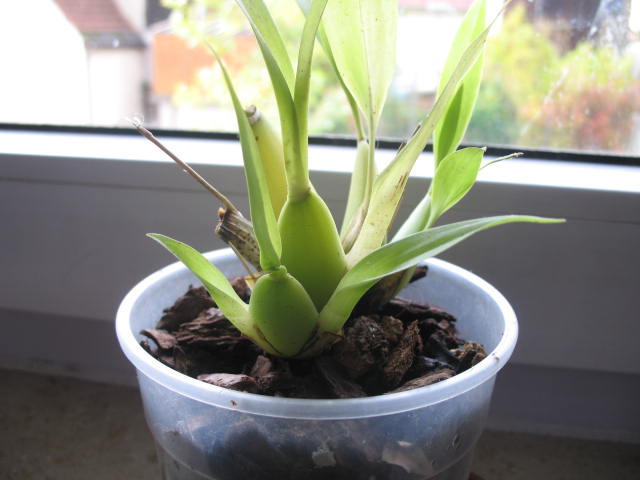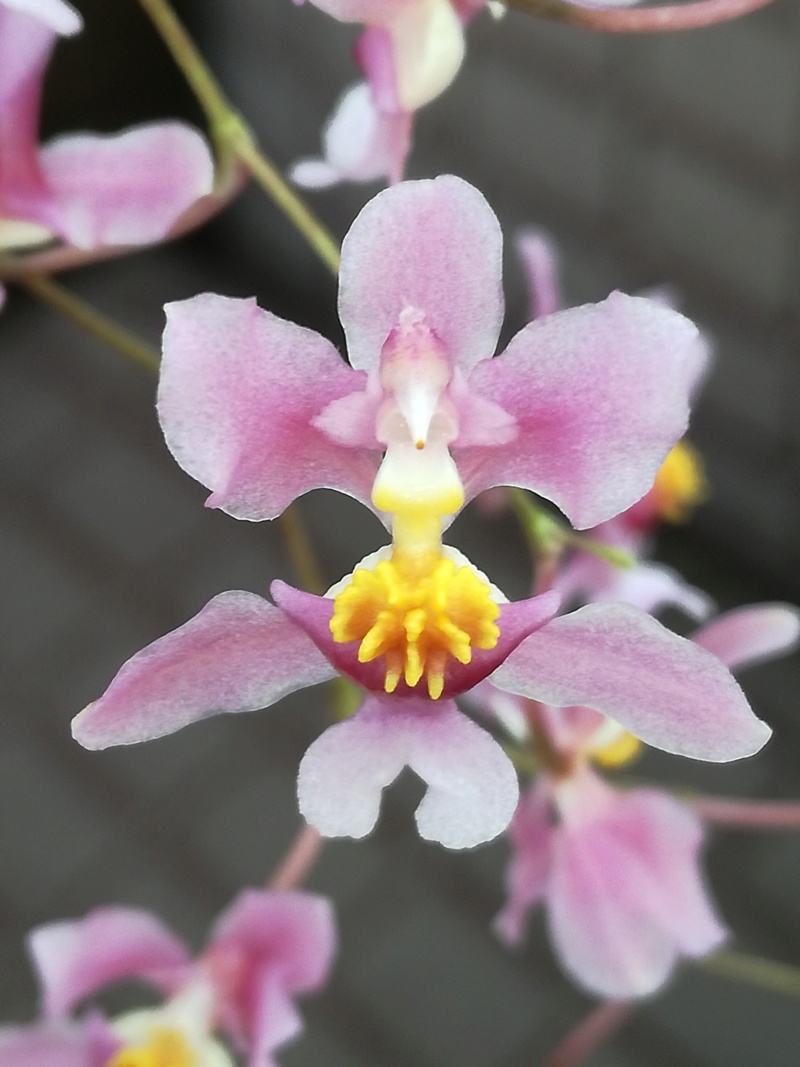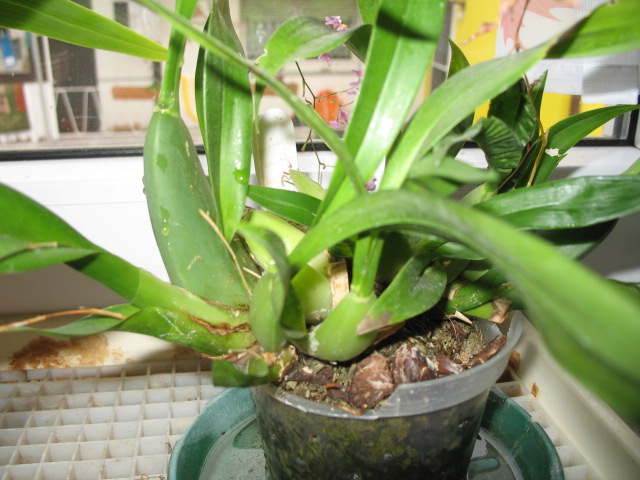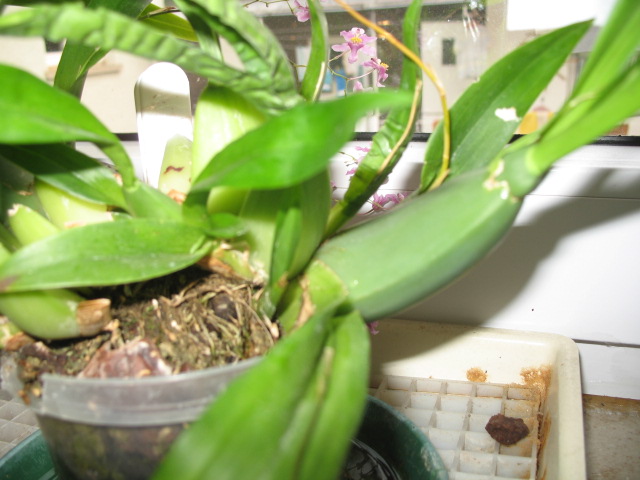bot. Name: Oncidium sotoanum
Gattung: Tribus Oncidieae
Synonyme: Onc. ornithorhynchum
Erstbeschreiber / Jahr: A. von Humboldt, Bonpland und Kunth/ 1815
Herkunft / Verbreitungsgebiet: Mexiko, Guatemala, El Salvador und Costa Rica.
Wuchsform: epiphytisch.
Temperaturbereich: temperiert bis kühl.
Ruhezeit: Nach der Blüte reduzierte Wassergaben bis zum Erscheinen des Neutriebes.
Lichtbedarf: hell, jedoch vor greller Mittagssonne geschützt.
Luftfeuchtigkeit/ Frischluftbedarf: um 60% bis 80% rel. LF, besonders in der Nacht hohe LF, viel Frischluft.
Wasserbedarf: während des Wachstums reichlich morgens sprühen, Pflanze sollte bis zum Abend abgetrocknet sein, aber dann hohe LF bei kühler Nacht.
Umtopfen/Substrat/Unterlage: im Topf, Substrat mittelfein, aber dennoch gut belüftet.
Kulturform: Hauptsächlich im Topf, aber auch aufgebunden bei hoher LF möglich.
Besonderheiten: Sie liebt temperierte Tage mit Licht und Sonne und kühle Nächte. Bildet mit der Zeit gute Horste
Bemerkungen: Alexander von Humboldt entdeckte die Pflanze in den Bergen Mexikos und beschrieb sie mit den o. g. Mitautoren auf Grund der Blütenform die an Vögel erinnert.
Schwierigkeitsgrad: leicht bis mittel.
Hauptblütezeit: im Herbst
Platzbedarf: gering bis mittel.

Anmerkung:
Oncidium ornithorhynchum = Oncidium sotoanum
The orchid horticultural world has many examples of plants that end up widespread in cultivation under one or more misnomers. This usually comes about because a species is described independently by two different taxonomists without knowledge of the other. Such is the case with Cattleya tigrina, known most commonly in cultivation under the newer name Cattleya leopoldii or Cattleya guttata var. leopoldii. However, once in a while, we find familiar species that are victims of completely mistaken identity.
So it appears is the case with that plant most of us have either grown or currently grow – Oncidium ornithorhynchum. This plant figures prominently in hybridizing in the oncidium alliance with some 80 primary hybrids including the popular Oncidium Twinkle as well as provides the source of the fragrance in the chocolate-scented, ever popular, Oncidium Sharry Baby.
While it’s true that what we grow with the name Oncidium ornithorhynchum is from Mexico and Central America, pink and, to most people, wonderfully fragrant – it isn’t Oncidium ornithorhynchum.
Jimenez and Hagsater, working in Central American orchidaceae have determined that the taxon described as Oncidium ornithorhynchum is actuallya South American species distributed from Ecuador, Colombia and Peru, and synonymous with Oncidium pyramidale Lindl.; a typically yellow and brown-flowered species.
The pink-flowered species we all grow is formally undescribed. In Lankesteriana 9(3) (January 2010), they formally describe this species from Mexico and Central America as Oncidium sotoanum R. Jimenez & Hagsater and an additional subspecies Oncidium sotoanum ssp. papalosmum R. Jimenez, known only from the Mexican states of Oaxaca and Chiapas, is described. The specific epithet (pronounced soe-toe-ANN-uhm) honors the recently deceased Miguel Angel Soto Arenas, respected around the world for his work in orchids of Mexico.
Gattung: Tribus Oncidieae
Synonyme: Onc. ornithorhynchum
Erstbeschreiber / Jahr: A. von Humboldt, Bonpland und Kunth/ 1815
Herkunft / Verbreitungsgebiet: Mexiko, Guatemala, El Salvador und Costa Rica.
Wuchsform: epiphytisch.
Temperaturbereich: temperiert bis kühl.
Ruhezeit: Nach der Blüte reduzierte Wassergaben bis zum Erscheinen des Neutriebes.
Lichtbedarf: hell, jedoch vor greller Mittagssonne geschützt.
Luftfeuchtigkeit/ Frischluftbedarf: um 60% bis 80% rel. LF, besonders in der Nacht hohe LF, viel Frischluft.
Wasserbedarf: während des Wachstums reichlich morgens sprühen, Pflanze sollte bis zum Abend abgetrocknet sein, aber dann hohe LF bei kühler Nacht.
Umtopfen/Substrat/Unterlage: im Topf, Substrat mittelfein, aber dennoch gut belüftet.
Kulturform: Hauptsächlich im Topf, aber auch aufgebunden bei hoher LF möglich.
Besonderheiten: Sie liebt temperierte Tage mit Licht und Sonne und kühle Nächte. Bildet mit der Zeit gute Horste
Bemerkungen: Alexander von Humboldt entdeckte die Pflanze in den Bergen Mexikos und beschrieb sie mit den o. g. Mitautoren auf Grund der Blütenform die an Vögel erinnert.
Schwierigkeitsgrad: leicht bis mittel.
Hauptblütezeit: im Herbst
Platzbedarf: gering bis mittel.

Anmerkung:
Oncidium ornithorhynchum = Oncidium sotoanum
The orchid horticultural world has many examples of plants that end up widespread in cultivation under one or more misnomers. This usually comes about because a species is described independently by two different taxonomists without knowledge of the other. Such is the case with Cattleya tigrina, known most commonly in cultivation under the newer name Cattleya leopoldii or Cattleya guttata var. leopoldii. However, once in a while, we find familiar species that are victims of completely mistaken identity.
So it appears is the case with that plant most of us have either grown or currently grow – Oncidium ornithorhynchum. This plant figures prominently in hybridizing in the oncidium alliance with some 80 primary hybrids including the popular Oncidium Twinkle as well as provides the source of the fragrance in the chocolate-scented, ever popular, Oncidium Sharry Baby.
While it’s true that what we grow with the name Oncidium ornithorhynchum is from Mexico and Central America, pink and, to most people, wonderfully fragrant – it isn’t Oncidium ornithorhynchum.
Jimenez and Hagsater, working in Central American orchidaceae have determined that the taxon described as Oncidium ornithorhynchum is actuallya South American species distributed from Ecuador, Colombia and Peru, and synonymous with Oncidium pyramidale Lindl.; a typically yellow and brown-flowered species.
The pink-flowered species we all grow is formally undescribed. In Lankesteriana 9(3) (January 2010), they formally describe this species from Mexico and Central America as Oncidium sotoanum R. Jimenez & Hagsater and an additional subspecies Oncidium sotoanum ssp. papalosmum R. Jimenez, known only from the Mexican states of Oaxaca and Chiapas, is described. The specific epithet (pronounced soe-toe-ANN-uhm) honors the recently deceased Miguel Angel Soto Arenas, respected around the world for his work in orchids of Mexico.

 Suchen
Suchen















